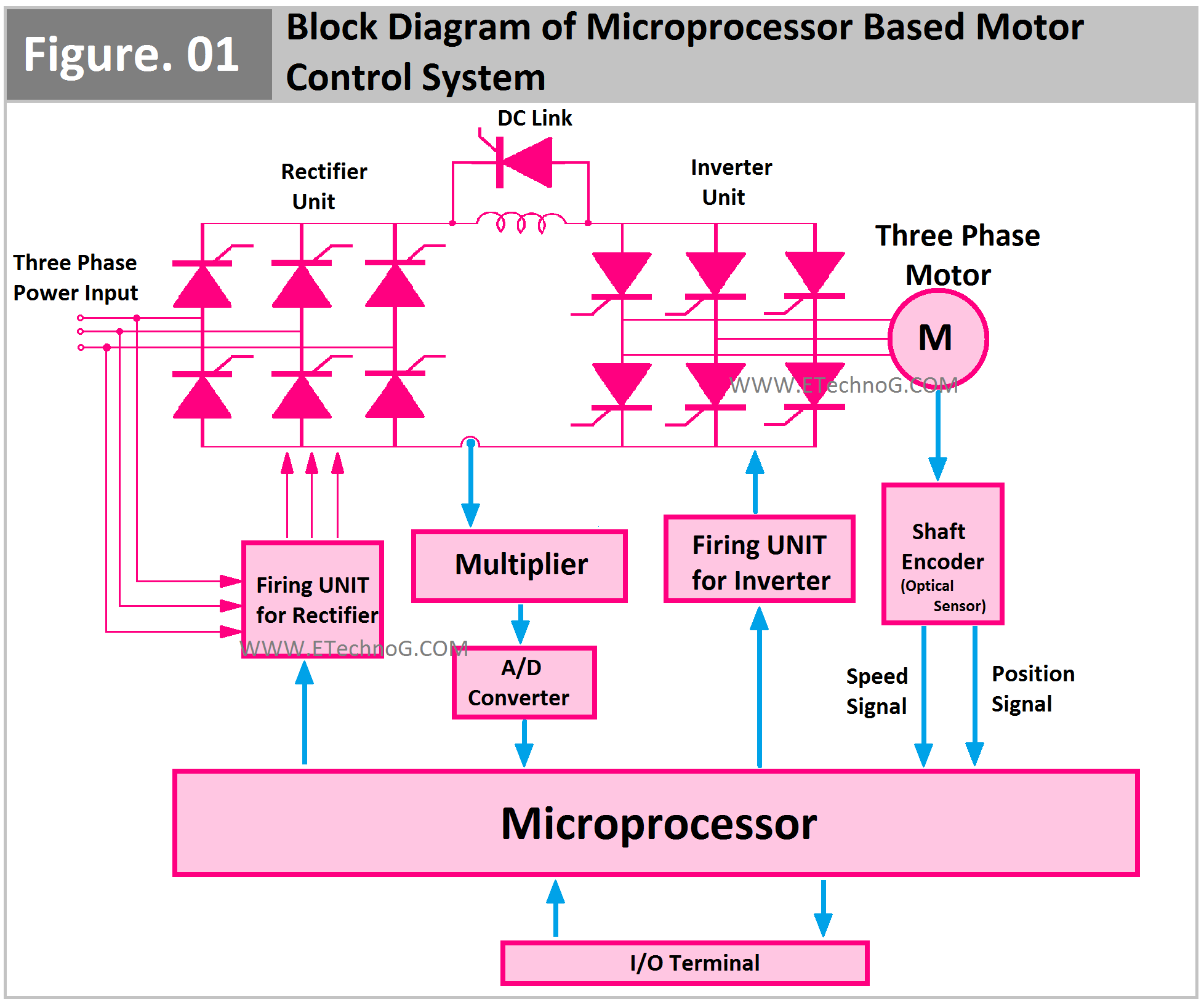Block Diagram of Microprocessor Based Motor Control System Explained
Hey, in this article we will learn how a microprocessor-based motor control system works. We will understand it with a block diagram so it will be easy to understand. Nowadays, in the automation system, microprocessor-based control systems are widely used. In electric cars, robotic devices, generally DC motors are used. In some automation systems AC motors(single phase or three phase) also used. Both the DC motor and AC motor operation using a microprocessor need completely different circuitries. In this article, we are going to know how the three-phase AC motor can be control using a microprocessor. Generally, three-phase induction motors and synchronous motors can be controlled using this microprocessor-based system.
First of all, let's see the block diagram.
According to the above block diagram, the main parts of a microprocessor-based three-phase motor control system are,
- Rectifier Unit
- Inverter Unit
- DC Link
- Firing Unit for Rectifier
- Firing Unit for Inverter
- Current and Voltage Sensor or Multiplier
- Analog to Digital(A/D) Converter
- Optical Sensor or Shaft Encoder for Position and Speed Measurement of the Motor shaft
- Microprocessor
- Input and Output or I/O Terminal
- Three Phase Motor
The simple operating principle of this system is, first, the three-phase input power supply is converted into a DC power supply by the rectifier circuit and then the DC power supply is again converted into the controlled three-phase AC power supply by the inverter circuit. This controlled AC power supply is applied to the motor. All the inverter, rectifier, and other circuits are controlled by the microprocessor unit. Now, let's discuss each part or block of this system,
Rectifier Unit
Here, a controlled rectifier circuit is used that converts three-phase AC into a DC power supply. The rectifier circuit is built with Thyristors such as SCRs. We know that the SCR operates according to the pulse signal applied to its gate terminals. So, here the pulse signal is provided by a firing unit for the rectifier circuit that is controlled by the microprocessor. The microprocessor provides a controlled signal to the firing unit and the firing unit controls each SCR individually.
Inverter Unit
Here, the inverter unit or inverter circuit converts the DC power into a controlled three-phase AC supply. This inverter circuit is also built with thyristors such as SCR. A firing unit for the inverter circuit is used to control or operate each SCR individually as per the controlled signal received from the microprocessor.
DC Link
DC link is nothing but an arrangement for connecting the output of the rectifier with the input of the inverter. In some circuits, a simple inductor is used. In some circuits, a switching component such as SCR is also used so it also can be controlled by the microprocessor.
Current and Voltage Sensor or Multiplier
It helps to measure the current, voltage, and other electrical quantities flowing in the circuit.
A/D Converter
As we know the microprocessor can operate with digital signal only. So the A/D converter is used to convert the analog sensing signal into a digital signal so it can be accessible by the microprocessor.
Optical Encoder or Sensor
It helps to measure the speed of the rotation of the motor shaft and the position of the shaft. It generates a signal according to the motor speed and position and provides it to the microprocessor.
Input and Output Modules
Input modules are those that help the microprocessor to collect input data from the external and internal of the system, For example, the optical sensor unit, and the current/voltage sensor unit helps to get the data from the internal of the system. On the other hand, the keyboard is the input device that gets the input data or instructions from the user.
The firing units for the inverter and rectifiers act as internal output modules that control the inverter and rectifiers as per the control signal generated by the microprocessor. Similarly, displays, alarms, and indicators are the external output devices that provide data to the user.
Microprocessor
It is the main processing device or brain of the whole system. It collects data and instructions from the different input modules. After processing those data and instructions, it generates the control signal to control the whole system and outputs the status signal so the normal user or human can understand the status of the system.
Not only a standalone microprocessor is used in the microprocessor based control system. Some additional devices and components such as memory units and converters are also installed in the system.
Read Also:
Thank you for visiting the website. keep visiting for more updates.

